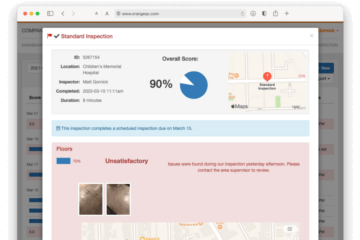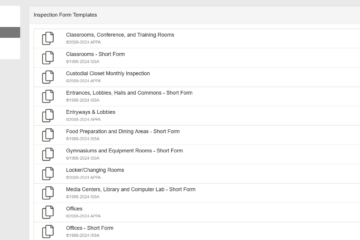By now, you probably know that janitorial or facility inspections are the key to getting a realistic picture of how things are going at your facilities. (If this doesn’t sound familiar, be sure to check out our Definitive Guide to Creating a Janitorial Checklist.)
So what are the different types of inspection forms, and how should you be using them? We’ll break down the three core inspection forms you should be using to track your progress, starting with the most important.
Standard inspections
Most teams will start out with a standard inspection. This is the easiest and quickest way to start improving your quality control process. There are two types of standard inspection forms:
- General purpose form: A high-level, single-page form that will be used in all of your client locations and facilities. This can be used in offices, schools, universities, airports, etc. and will include general items such as floors, windows, trash, horizontal surfaces, and more. Check out our free printable janitorial inspection checklist for an example to get you started. (If you’re looking for an editable version, open the inspection checklist in Google Drive here, then make a copy to edit however you’d like.)
- Area type form: A more specific form you can use to track certain areas, such as classrooms, restrooms, high-traffic areas, public spaces, or gymnasiums. This will include survey items or line items in those areas to meet a certain standard. For example, ISSA’s area type form for the classroom includes line items on floors, student desks, teacher’s desk, door knobs, and more. Customize the line items to reflect what your cleaning team is responsible for in each space.
You will need to adopt a rating system for your standard inspection form. Common rating systems include pass/fail, 1–3, 1–5 rating, or APPA Custodial Service Levels. (For more information on which rating system is best for your team, check out our in-depth look at the options.) Keeping the system consistent over time will make it easier to compare results and track trends.
How often and when should I do my standard inspections?
How often you perform standard inspections will vary based on the type of space and client needs, but they are typically done at least once a month. Sometimes, our customers will perform them twice a month, or even weekly. High-traffic facilities, such as airport bathrooms, may even be inspected multiple times a day.
Performing regular inspections will allow you to catch mistakes before they become big problems.
In most cases, the best time to perform a standard inspection is at the end of the shift. For the most accurate picture of how your team is doing, it’s best if they don’t know when the inspection is happening. If team members are expecting an inspection, they may perform better than on a typical day. (Of course, if they know you are inspecting regularly, that higher performance is another bonus.)
What happens after your standard inspection is complete?
Use the information gathered from these inspections to address deficiencies and ensure they don’t happen again. A good way to do this is to train your staff in the appropriate areas. Be sure to compliment your team on what they’re doing well, too.
Because you’ll perform standard inspections on a regular basis, they should also be the keystone of your quality control data tracking. The OrangeQC dashboard and reports, for instance, helps you see trends at a glance or dig into variations in the data.

Finally, send it to your client! You don’t have to send the full report, and you don’t need to do it each time, but you can break down the information in a digestible way and tailor it to each client’s needs. (OrangeQC compiles client-friendly reports automatically.) This is a good way to build trust with the client and allow them to see how you are delivering on your promises or making improvements.
Public Relations (PR) reports
The Public Relations (PR) report, sometimes called a Joint Management inspection, involves clients or key stakeholders in the inspection process. These inspections are critical in helping you and the customer see eye to eye on how your team is doing.
The PR report gives the client the opportunity to share with the supervisor how they think the custodial team is doing. If you think your team is performing at a 95% but your client views it as a 75%, you now have the opportunity to address the deficiency and close that gap between their expectations and your perceptions of how you’re doing.
You or a member of your team will work directly with the customer or key stakeholder to complete the PR report. You’ll usually know who the key stakeholders are from the contract, but it’s also a good idea to get others involved. For example, students could be considered stakeholders at a university.
One of our clients, the University of Minnesota Office of Classroom Management, manages 350 spaces in more than 50 buildings, which are used by up to 22,000 students per hour. Find out how they use OrangeQC’s PR reports with their team of 20 students across campus who perform inspections and fix issues.
When should I use a PR report?
We recommend first using the PR report before even starting the contract, to establish a baseline and set expectations. After that, these should be completed frequently, especially for high-priority accounts. We often see them being done on a monthly, quarterly, or semi-annual schedule.
If you’re just starting to use a PR report with an existing client, you may want to start with a quarterly goal, then adjust based on the needs of your client and your team.
Read our in-depth guide on best practices for the PR report.
End-of-day/End-of-shift reports
The end-of-day or end-of-shift report will allow your team to address any incidents, safety violations, concerns, equipment issues, whether or not the staff was in uniform or wearing their employee badges, etc. Think about those things that the team members could share with management that would make their job easier or allow them to be better prepared.
The report gives you a pulse on how the process and standards you have set for your team are playing out on a day-to-day basis.
Any deficiencies identified in the end-of-day report can be flagged in OrangeQC to automatically generate a ticket or email. These things won’t affect the cleaning score, but this form allows you to have an open line of communication for people in the field all the way up to management so these items can be addressed, make your team more efficient, and make sure the team members feel involved in the process.
For best results, use all three
Your team may already be using one or more of these types of inspection forms, but we’ve seen many of our clients find the most value in using all three.
While the standard inspection allows you to quickly start improving how you evaluate your team’s progress, the PR report facilitates collaboration between you and your clients, and the end-of-day or end-of-shift report gives your employees confidence that their success and needs are important to you.
OrangeQC was designed to empower your team to inspect faster, smarter, and in real time so you can act on the results. Start your free 30-day trial of OrangeQC to see how simple inspections can be.



